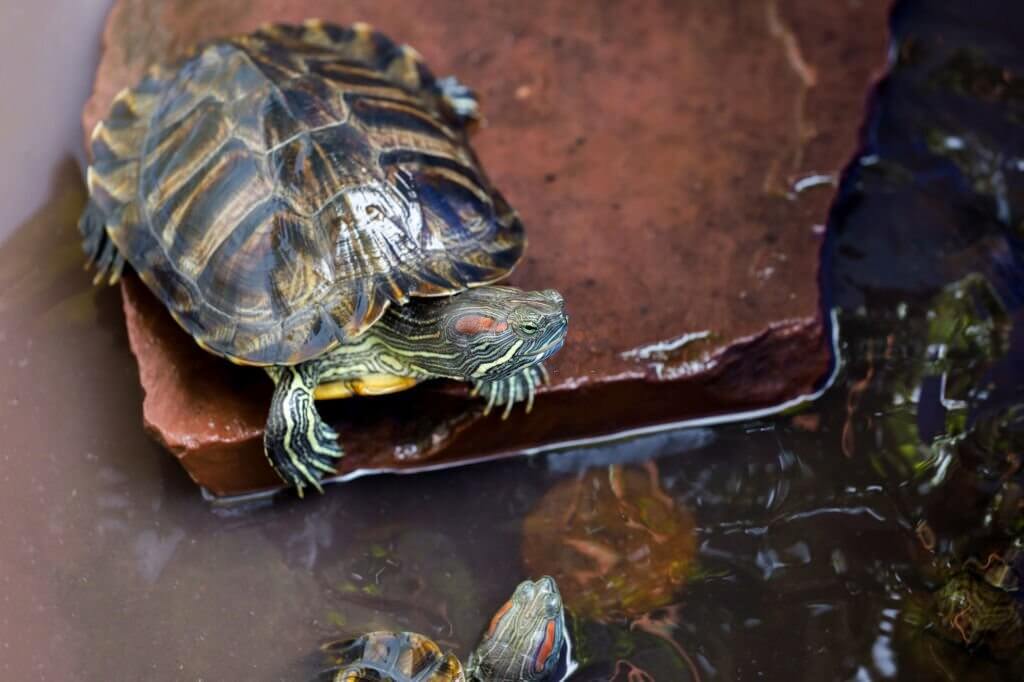Are you curious about what brings joy to your shelled companions?
Turtles enjoy interactive toys like floating balls, food puzzles, and enrichment activities that mimic their natural environment.
But there’s more to turtle playtime than replicas of their natural habitat. Stick around as we uncover some surprising turtle entertainments that could enrich your pet’s life!
Safe Toys For Turtles
Turtles do enjoy playing, although not in the same way as more traditional pets like dogs or cats. Here are some example toys you can give them.
- Empty shells: Who knew that old, empty shells could turn into treasure in a turtle tank? Larger shells from other mollusks can be intriguing objects for turtles to investigate, pushing them around or using them as hiding spots.
- Mirrors: Brief, supervised interactions with a mirror can stimulate some turtles, as they might react to their reflection. However, this should be used sparingly to avoid causing stress.
- Food puzzles: Turtles can be stimulated by food puzzles that require them to figure out how to access their food. This could be as simple as placing food in a location that requires effort to reach or using specially designed reptile feeder toys.
- Floating objects: Turtles often push or chase floating objects around, whether a ping pong ball, a small buoy, or even a harmless floating toy.
- Live or artificial plants: Turtles enjoy navigating through or resting in plants. Live aquatic plants can also contribute to the tank’s ecosystem, but ensure they are safe for turtles, as some might try to eat them.
DIY Turtle Entertainment: Homemade Fun
Floating Food Balls
Engage your turtle’s hunting instincts with homemade floating food balls. Take a piece of lettuce, kale, or any turtle-safe leafy green and wrap it into a tight ball using a thin, non-toxic string like untreated cotton. Float these balls in the water, and watch your turtle chase and nibble on them. It’s a fun way to make mealtime interactive and exciting.
Pebble Puzzle
Stimulate your turtle’s foraging instinct with a pebble puzzle. Fill a shallow dish with large, smooth pebbles, then hide some of your turtle’s favorite treats among the pebbles. This setup encourages your turtle to “hunt” for their food, providing both mental and physical exercise.
Shell Hideaway
Use a large coconut shell to create a hideaway for your turtle. Make sure to clean it thoroughly and remove any fibers. Place the shell in a corner of the tank to provide a secure spot for your turtle to retreat to when they need some quiet time.
DIY Rafts
Construct a floating raft using a piece of cork bark or untreated, buoyant wood. Ensure the edges are smooth and the surface is large enough for your turtle to climb onto comfortably. You can tether the raft to the side of the tank with a non-toxic string to keep it stationary.
The Importance Of Environmental Enrichment
Promoting Natural Behaviors
Turtles explore, foraging, basking, and interacting with their surroundings in the wild. A well-enriched environment encourages these instinctual activities, preventing boredom and promoting physical health.
For instance, foraging toys and puzzles stimulate their minds, while varied terrain and climbing opportunities encourage physical activity.
Stress Reduction
A monotonous or inappropriate environment can lead to stress and anxiety in turtles, manifesting in behaviors like excessive digging, aggression, or even health issues. By providing an enriched and varied habitat, you offer your turtle entertainment and a sense of security and normalcy, reducing stress and enhancing their quality of life.
Cognitive Development
Just like humans, turtles benefit from mental stimulation. Solving puzzles, navigating new layouts, and interacting with different objects can improve cognitive functions and adaptability.
Social Interaction
For more social turtle species, environmental enrichment can also include safe interactions with other turtles. This must be carefully managed to avoid aggression but can contribute to a more dynamic and naturalistic social environment, enriching their social development and behaviors.
Interactive Play: Bonding With Your Turtle
Start by getting your turtle accustomed to your presence. Spend time near their habitat, speaking softly to help them associate your voice with safety. When handling your turtle, always be gentle and supportive, scooping them up from beneath rather than grabbing from above, which can startle them. Limit handling sessions to short periods to avoid stress, gradually increasing the time as your turtle becomes more comfortable.
Allowing your turtle to explore outside their tank can be a thrilling adventure for them, offering new textures, smells, and sights. Ensure the exploration area is turtle-proofed, removing potential hazards or escape routes. Stay close to supervise their adventure, ensuring they don’t ingest anything harmful or get into trouble. This change of scenery can be incredibly stimulating and enriching for your turtle.
Final Thoughts
Turtles enjoy a variety of playthings, from floating toys and natural decorations like plants to engaging with safe, homemade items and exploring their environment under your watchful eye. Remember, the key to a happy turtle is not just about the toys you provide but also about creating a stimulating environment that mimics their natural habitat and encourages their natural behaviors.
Related Posts:

